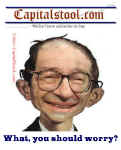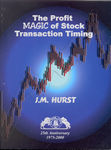|
Subscriber Sections The
Anals MoGauge © Subscription Help (Login, Password etc.) Free Forums Resources Market Stats and Kitco Thumbnail Charts Bear
Essentials Marketviews with Ike Iossif Prudentbear.com
Humor Wall Street Follies Financial Funnies Hilarious! by stoolie prolerbear Not
In My Backyard for Capitalstool. Support the Stool! |

We
don't know and neither do they.
About That Three To Five Year Horizon
Stepan N. Stool, PH&D March 6, 2001
James "Dow 36,000"
Glassman made a comment Tuesday Night on the Caint Nobody Buy Channel
that caught Dr. Stool's ear. He said that over the last 100 years,
stocks had, on average, returned 12% annually. Dr. Stool put the
proctoscope on that statement and saw it for what it is.
First of all, what measure is that 12% by, Mr. Assman? Must be the Dow Jones Industrial Average. Dr. Stool doesn't know of any other measure that's been around for 100 years. So let's see now, how have those 12 Dow stocks done in the last 100 years. Here's one, American Cotton Oil. Hmmm. And how about Distilling and Cattle Feeding, or LaClede Gas. Then there's Tennessee Coal and Iron and U.S. Leather Preferred. And of course, Nash Motors, but that came later. And how can we forget Woolworth? Here's one that they put in, in 1930, Hudson Motor. Oops, let's not forget the Victor Talking Machine Company. Or Johns Manville and International Shoe. International Harvester either.
Buy and hold? 12% return? Somebody better tell Dow Jones and Co. about that buy and hold. And, by the way, the Dow's compound rate of return over that 100 years was 5.16%.
Secondly, what the hell does 100 years have to do with investing? This is a cheap trick statement from a slick, cheap trick, hustler. Dr. Stool will tell you what 100 years has to do with investing. Think of all the investors you've ever known or heard of. How many of them had a 100 year investing career?
Most of us, if we're lucky, have an investing career of maybe 30 years. We call that an era. Your success as an investor depends largely on when you were born, and the era in which your disposable income permitted you to invest. If 12% really was the average return over 100 years, (the Big Lie if repeated often enough becomes believable), then what happens if your investing career begins late in a long period of returns double that amount.
Dr. Stool had a great uncle who had the good sense and good fortune to become a wonderful physician during the early years of the Great Depression. He had an income when few did, and a deep and abiding faith in the promise of America, when few did. He also had a bank "holiday" to encourage him NOT to put his money in the bank. So he put his money into stocks, which back then included an archaic financial device called a "dividend." Now, that really wasn't a hard choice to make, since virtually no one thought of the bank as a safe place to put your money.
So plowing that cash into the market year after year in the pits of the depression, when stocks had 6% dividends and PE's of 5 and 6, needless to say Great Uncle Stool did very well over the next 30 years.
Then there is another doctor, whose initials are Dr. Stool, who, as a young hot dog vendor on the streets of Philadelphia, flush with hot dog cash, put his money into the market in the late 1960s, after 15 years of mostly rising markets. So like all enthusiastic young investors with a deep and abiding faith in the promise of America, he bought. And the stocks went up for a year. But soon the stocks went down. They were "good stocks", so he held 'em. And they went down some more, but he knew they were good stocks, and they would come back. So with faith in the future, he held, because it seemed certain that soon, the stocks would go up. But every year, 1968, 1969, 1970, 1971, 1972, 1973, 1974, they just kept going down.
In the end, what did Dr. Stool get out of buying and holding for three to five years? Severe cases of hemorrhoids and mood disorder. But you know that.
That buy and hold, 3-5 year stuff definitely works, if you're lucky enough to be born at the right time. But if you weren't, you'd better be willing to sell 'em short. Otherwise, you'll never have any fun.
Unless of course you can pick the ones that will be around in 100 years.
And hold 'em.
|



